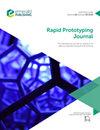选择性激光烧结工艺中不同材料回用率对聚酰胺12力学性能的影响
IF 3.6
4区 工程技术
Q1 ENGINEERING, MECHANICAL
引用次数: 0
摘要
增材制造(AM)是过去几年最受关注的工艺之一。AM打印复杂的零件和项目从3D文件关于不同的材料,如聚合物。此外,有不同的增材制造技术可用于聚合物,如选择性激光烧结。在SLS技术中,聚酰胺11和12占据了88%的市场份额。这些材料成本高,每次印刷平均使用50%的原始材料。可以使用较低比例的原始材料,但建议至少使用30%。原始材料率低会降低机械性能。设计/方法/方法本研究旨在评估在SLS工艺制造的零件中PA12的重复使用百分比对机械性能的影响。用50/50、40/60、30/70、20/80和10/90的比例制备PA12样品。我们考虑了三种不同的印刷方向来比较样品的力学性能:水平、垂直和垂直。结果表明:随着材料重复利用率的增加,复合材料的抗拉强度极限(TSL)、抗折强度极限和邵氏D硬度均降低;可视化的另一个方面是垂直试件呈现的脆弱行为。此外,DSC分析表明结晶度降低了2%。扫描电镜图像显示拉伸试样断口处存在球形空洞和未融合的PA12颗粒。材料的热历史和未熔颗粒会降低材料的性能。我们观察到,随着材料重复利用率的增加,材料的力学性能(如TSL、弯曲强度极限和硬度)降低。此外,该工艺呈现出印刷方向依赖性,其中垂直方向在使用的方向之间表现为更脆。本文章由计算机程序翻译,如有差异,请以英文原文为准。
Evaluation of the mechanical properties of polyamide 12 regarding different percentages of reused material in the selective laser sintering process
Purpose Additive manufacturing (AM) has been one of the most highlighted processes of the last few years. AM prints complex parts and items from 3D files regarding different materials, such as polymers. Moreover, there are different AM techniques available for polymers, such as selective laser sintering. In the SLS technology, polyamides 11 and 12 lead 88% of the market. These materials are high-cost and use an average of 50% of virgin material at each printing. It is possible to use lower rates of virgin material, but at least 30% is recommended. Low rates of virgin material decrease mechanical properties. Design/methodology/approach This study aims to evaluate the influence on the mechanical properties of the percentage of reused PA12 in parts manufactured by the SLS process. The specimens of PA12 were manufactured with a percentage of virgin/reused polymer of 50/50, 40/60, 30/70, 20/80 and 10/90. We considered three distinct printing directions to compare the mechanical properties of the specimens: horizontal, perpendicular and vertical. Findings The results showed that when the percentage of reused material increases, the tensile strength limit (TSL), flexural strength limit and Shore D hardness decrease. Another aspect visualized was the fragile behavior presented in the vertical specimens. In addition, DSC analysis indicated a 2% reduction of crystallinity. Scanning electron microscopy images revealed spherical voids and unfused particles of PA12 at the fracture of tensile test specimens. The material thermal history and unfused particles could decrease the material properties. Originality/value We observed that the mechanical properties, such as the TSL, flexural strength limit and hardness, decrease as the percentage of reused material increases. In addition, the process presented a printing-direction dependence, where the vertical direction presented as the more brittle between the ones used.
求助全文
通过发布文献求助,成功后即可免费获取论文全文。
去求助
来源期刊

Rapid Prototyping Journal
工程技术-材料科学:综合
CiteScore
8.30
自引率
10.30%
发文量
137
审稿时长
4.6 months
期刊介绍:
Rapid Prototyping Journal concentrates on development in a manufacturing environment but covers applications in other areas, such as medicine and construction. All papers published in this field are scattered over a wide range of international publications, none of which actually specializes in this particular discipline, this journal is a vital resource for anyone involved in additive manufacturing. It draws together important refereed papers on all aspects of AM from distinguished sources all over the world, to give a truly international perspective on this dynamic and exciting area.
-Benchmarking – certification and qualification in AM-
Mass customisation in AM-
Design for AM-
Materials aspects-
Reviews of processes/applications-
CAD and other software aspects-
Enhancement of existing processes-
Integration with design process-
Management implications-
New AM processes-
Novel applications of AM parts-
AM for tooling-
Medical applications-
Reverse engineering in relation to AM-
Additive & Subtractive hybrid manufacturing-
Industrialisation
 求助内容:
求助内容: 应助结果提醒方式:
应助结果提醒方式:


